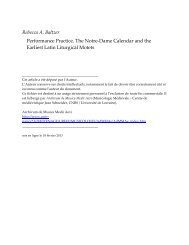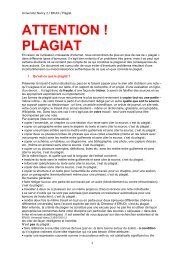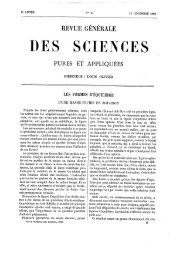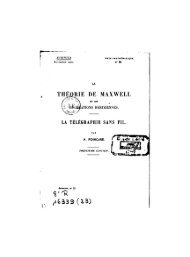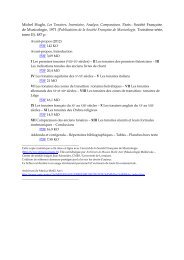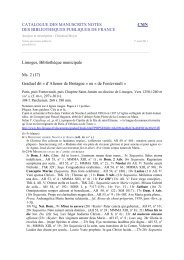You also want an ePaper? Increase the reach of your titles
YUMPU automatically turns print PDFs into web optimized ePapers that Google loves.
Chaucer's General Prologue<br />
159_(12U<br />
sleeplessness is not for reasons of frustration but of active sexual<br />
prowess. The last two lines again must come from the Squire, who,<br />
perhaps realising that he has been carried away in his confidences to a<br />
stranger, recalls his more respectable qualities and duties as his<br />
father's son: politeness, humble bearing and ready helpfulness, as well<br />
as useful skill in menial manual tasks like carving, filial qualities<br />
which add up to a Boy-Scout image.<br />
When the Yeoman is introduced, there is some doubt as to which<br />
of the two, the father or the son, this man actually serves,<br />
A Yeman hadde he and servanz namo<br />
At that tyme, for hym liste ryde so,<br />
And he was clad in cote and hood of greene, (ll. 101-103)<br />
although most readers take the he to mean the father. 17 The allusion to<br />
the particular moment at that tyme clearly indicates Free Indirect<br />
Speech, with the Knight or Squire explaining that the scarcity of<br />
followers is a matter of choice rather than of necessity to the Narrator,<br />
who then takes over with his own observations on the Yeoman's<br />
appearance. Unlike the Knight and the Squire, the Yeoman does not<br />
seem to introduce himself, but has to be accounted for by his superior.<br />
The first comments that might come from the Yeoman, or perhaps are<br />
still those of the Knight / Squire speaking about his servant, are those<br />
which convey approbation of his arrows, which :<br />
Under his belt he bar full thriftily.<br />
(Well koude he dresse his takel yemanly), (ll. 105-106)<br />
where we can distinguish between the Past Simple (e) of datable time<br />
of the "bearing" or "wearing" of his arrows (something the Narrator<br />
could see for himself) and the Past Simple ( f ) of vaguely general time<br />
in koude he dresse, which suggests an account. This last refers to the<br />
many unspecified occasions which, added up together, prove the<br />
possession of a skill (something the Narrator had to be told). The<br />
close-cropped head and the sun-burnt face of the Yeoman are<br />
17 . This is the opinion in Riverside, p. 25, note 101.




